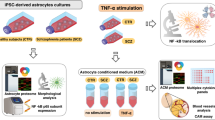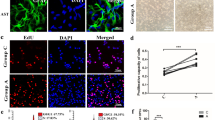Abstract
Leukoencephalopathy with vanishing white matter (VWM) is an inherited leukoencephalopathy characterized by progressive rarefaction of cerebral white matter. Dysfunction of patient astrocyte plays a central role in the pathogenesis, while the immaturity of oligodendrocyte is probably secondary. How eIF2B mutant astrocytes affect the maturation and myelination of oligodendrocyte precursor cells (OPCs) is unclear yet. We used induced pluripotent stem cells (iPSCs) derived from our patient with EIF2B5 mutations to differentiate into astrocytes (AS) and OPCs, and aimed to verify that patient astrocytes inhibited the differentiation of OPCs by abnormalities of secreted proteins. eIF2B mutant astrocytes and astrocyte-conditioned medium (ACM) both inhibited the maturation of OPCs. It was revealed that 13 promising proteins exhibited a similar up- or downregulation by the PRM method correlated well with TMT results. eIF2B mutant astrocytes may secrete abnormal extracellular matrix (HA, LAMA4, BGN, FBN1, VASN, PCOLCE, MFAP4), cytokines (IL-6, CRABP1, ISG15), growth factors (PDGF-AA, CNTF, IGF-II, sFRP1, SERPINF1) and increased FABP7, which might lead to the differentiation and maturation disorder of OPCs. We analyzed the astrocyte-conditioned medium to find the key secretory molecules affecting the differentiation and maturation of OPCs, which provides potential clues for further research on the mechanism of VWM.






Similar content being viewed by others
Data Availability
The original contributions presented in the study are included in the article and supplementary material, further inquiries can be directed to the corresponding author on reasonable request.
References
Bugiani M, Boor I, Powers JM, Scheper GC, van der Knaap MS (2010) Leukoencephalopathy with vanishing white matter: a review. J Neuropathol Exp Neurol 69:987–996
Van Haren K, van der Voorn JP, Peterson DR, van der Knaap MS, Powers JM (2004) The life and death of oligodendrocytes in vanishing white matter disease. J Neuropathol Exp Neurol 63:618–630
Bugiani M, Vuong C, Breur M, van der Knaap MS (2018) Vanishing white matter: a leukodystrophy due to astrocytic dysfunction. Brain Pathol 28:408–421
Dietrich J, Lacagnina M, Gass D, Richfield E, Mayer-Pröschel M, Noble M, Torres C, Pröschel C (2005) EIF2B5 mutations compromise GFAP+ astrocyte generation in vanishing white matter leukodystrophy. Nat Med 11:277–283
Zhou L, Li P, Chen N, Dai LF, Gao K, Liu YN, Shen L, Wang JM, Jiang YW, Wu Y (2019) Modeling vanishing white matter disease with patient-derived induced pluripotent stem cells reveals astrocytic dysfunction. CNS Neurosci Ther 25:759–771
Jha MK, Kim JH, Song GJ, Lee WH, Lee IK, Lee HW, An SSA, Kim S, Suk K (2018) Functional dissection of astrocyte-secreted proteins: implications in brain health and diseases. Prog Neurobiol 162:37–69
Dooves S, Bugiani M, Postma NL, Polder E, Land N, Horan ST, van Deijk AL, van de Kreeke A, Jacobs G, Vuong C, Klooster J, Kamermans M, Wortel J, Loos M, Wisse LE, Scheper GC, Abbink TE, Heine VM, van der Knaap MS (2016) Astrocytes are central in the pathomechanisms of vanishing white matter. J Clin Investig 126:1512–1524
Li P, Sun X, Ma Z, Liu Y, Jin Y, Ge R, Hao L, Ma Y, Han S, Sun H, Zhang M, Li R, Li T, Shen L (2016) Transcriptional reactivation of OTX2, RX1 and SIX3 during reprogramming contributes to the generation of RPE cells from human iPSCs. Int J Biol Sci 12:505–517
Witkamp D, Oudejans E, Hu ANGV, Hoogterp L, Krzywańska AM, Žnidaršič M, Marinus K, de Veij Mestdagh CF, Bartelink I, Bugiani M, van der Knaap MS, Abbink TEM (2022) Guanabenz ameliorates disease in vanishing white matter mice in contrast to sephin1. Ann Clin Transl Neurol 9(8):1147
Jones P, Binns D, Chang HY, Fraser M, Li W, McAnulla C, McWilliam H, Maslen J, Mitchell A, Nuka G, Pesseat S, Quinn AF, Sangrador-Vegas A, Scheremetjew M, Yong SY, Lopez R, Hunter S (2014) InterProScan 5: genome-scale protein function classification. Bioinformatics 30:1236–1240
da Huang W, Sherman BT, Lempicki RA (2009) Bioinformatics enrichment tools: paths toward the comprehensive functional analysis of large gene lists. Nucleic Acids Res 37:1–13
Franceschini A, Szklarczyk D, Frankild S, Kuhn M, Simonovic M, Roth A, Lin J, Minguez P, Bork P, von Mering C, Jensen LJ (2013) STRING v9.1: protein-protein interaction networks, with increased coverage and integration. Nucleic Acids Res 41:D808-815
Rauniyar N (2015) Parallel reaction monitoring: a targeted experiment performed using high resolution and high mass accuracy mass spectrometry. Int J Mol Sci 16:28566–28581
Lancaster MA, Renner M, Martin CA, Wenzel D, Bicknell LS, Hurles ME, Homfray T, Penninger JM, Jackson AP, Knoblich JA (2013) Cerebral organoids model human brain development and microcephaly. Nature 501:373–379
Kipp M, Clarner T, Gingele S, Pott F, Amor S, van der Valk P, Beyer C (2011) Brain lipid binding protein (FABP7) as modulator of astrocyte function. Physiol Res 60:S49-60
Santos AK, Vieira MS, Vasconcellos R, Goulart VAM, Kihara AH, Resende RR (2019) Decoding cell signalling and regulation of oligodendrocyte differentiation. Semin Cell Dev Biol 95:54–73
Liu Y, Han SS, Wu Y, Tuohy TM, Xue H, Cai J, Back SA, Sherman LS, Fischer I, Rao MS (2004) CD44 expression identifies astrocyte-restricted precursor cells. Dev Biol 276:31–46
Bugiani M, Postma N, Polder E, Dieleman N, Scheffer PG, Sim FJ, van der Knaap MS, Boor I (2013) Hyaluronan accumulation and arrested oligodendrocyte progenitor maturation in vanishing white matter disease. Brain 136:209–222
Back SA, Tuohy TM, Chen H, Wallingford N, Craig A, Struve J, Luo NL, Banine F, Liu Y, Chang A, Trapp BD, Bebo BF Jr, Rao MS, Sherman LS (2005) Hyaluronan accumulates in demyelinated lesions and inhibits oligodendrocyte progenitor maturation. Nat Med 11:966–972
Buser JR, Maire J, Riddle A, Gong X, Nguyen T, Nelson K, Luo NL, Ren J, Struve J, Sherman LS, Miller SP, Chau V, Hendson G, Ballabh P, Grafe MR, Back SA (2012) Arrested preoligodendrocyte maturation contributes to myelination failure in premature infants. Ann Neurol 71:93–109
Cho AN, Jin Y, Kim S, Kumar S, Shin H, Kang HC, Cho SW (2019) Aligned brain extracellular matrix promotes differentiation and myelination of human-induced pluripotent stem cell-derived oligodendrocytes. ACS Appl Mater Interfaces 11:15344–15353
Cabilly Y, Barbi M, Geva M, Marom L, Chetrit D, Ehrlich M, Elroy-Stein O (2012) Poor cerebral inflammatory response in eIF2B knock-in mice: implications for the aetiology of vanishing white matter disease. PLoS ONE 7:e46715
Brück W, Herms J, Brockmann K, Schulz-Schaeffer W, Hanefeld F (2001) Myelinopathia centralis diffusa (vanishing white matter disease): evidence of apoptotic oligodendrocyte degeneration in early lesion development. Ann Neurol 50:532–536
Schönrock LM, Gawlowski G, Brück W (2000) Interleukin-6 expression in human multiple sclerosis lesions. Neurosci Lett 294:45–48
Lin YL, Persaud SD, Nhieu J, Wei LN (2017) Cellular retinoic acid-binding protein 1 modulates stem cell proliferation to affect learning and memory in male mice. Endocrinology 158:3004–3014
Zhou MJ, Chen FZ, Chen HC, Wan XX, Zhou X, Fang Q, Zhang DZ (2017) ISG15 inhibits cancer cell growth and promotes apoptosis. Int J Mol Med 39:446–452
Woodruff RH, Fruttiger M, Richardson WD, Franklin RJ (2004) Platelet-derived growth factor regulates oligodendrocyte progenitor numbers in adult CNS and their response following CNS demyelination. Mol Cell Neurosci 25:252–262
Vana AC, Flint NC, Harwood NE, Le TQ, Fruttiger M, Armstrong RC (2007) Platelet-derived growth factor promotes repair of chronically demyelinated white matter. J Neuropathol Exp Neurol 66:975–988
Albrecht PJ, Enterline JC, Cromer J, Levison SW (2007) CNTF-activated astrocytes release a soluble trophic activity for oligodendrocyte progenitors. Neurochem Res 32:263–271
Stankoff B, Aigrot MS, Noël F, Wattilliaux A, Zalc B, Lubetzki C (2002) Ciliary neurotrophic factor (CNTF) enhances myelin formation: a novel role for CNTF and CNTF-related molecules. J Neurosci 22:9221–9227
Zeger M, Popken G, Zhang J, Xuan S, Lu QR, Schwab MH, Nave KA, Rowitch D, D’Ercole AJ, Ye P (2007) Insulin-like growth factor type 1 receptor signaling in the cells of oligodendrocyte lineage is required for normal in vivo oligodendrocyte development and myelination. Glia 55:400–411
Mewar R, McMorris FA (1997) Expression of insulin-like growth factor-binding protein messenger RNAs in developing rat oligodendrocytes and astrocytes. J Neurosci Res 50:721–728
Noelanders R, Vleminckx K (2017) How Wnt signaling builds the brain: bridging development and disease. Neuroscientist 23:314–329
Tian H, Biehs B, Chiu C, Siebel CW, Wu Y, Costa M, de Sauvage FJ, Klein OD (2015) Opposing activities of Notch and Wnt signaling regulate intestinal stem cells and gut homeostasis. Cell Rep 11:33–42
Tayyab M, Shahi MH, Farheen S, Mariyath MPM, Khanam N, Castresana JS, Hossain MM (2018) Sonic hedgehog, Wnt, and brain-derived neurotrophic factor cell signaling pathway crosstalk: potential therapy for depression. J Neurosci Res 96:53–62
Kamizato K, Sato S, Shil SK, Umaru BA, Kagawa Y, Yamamoto Y, Ogata M, Yasumoto Y, Okuyama Y, Ishii N, Owada Y, Miyazaki H (2019) The role of fatty acid binding protein 7 in spinal cord astrocytes in a mouse model of experimental autoimmune encephalomyelitis. Neuroscience 409:120–129
Cheng A, Jia W, Kawahata I, Fukunaga K (2021) A novel fatty acid-binding protein 5 and 7 inhibitor ameliorates oligodendrocyte injury in multiple sclerosis mouse models. EBioMedicine 72:103582
Funding
This research was supported by the Program of the Natural Science Foundation of China (Grant Number [82171694] and [81901155]), and Beijing Natural Science Foundation (Grant Number [L202034]).
Author information
Authors and Affiliations
Contributions
All authors contributed to the study conception and design. Material preparation, data collection and analysis were performed by JD, JZ and YW. The first draft of the manuscript was written by JD and all authors commented on previous versions of the manuscript. All authors read and approved the final manuscript.
Corresponding author
Ethics declarations
Competing Interests
The authors have no relevant financial or non-financial interests to disclose.
Ethical Approval
This study was performed in line with the principles of the Declaration of Helsinki. Approval was granted by Medical Ethics Committee of Peking University First Hospital (2022[176]).
Consent to Participate
The written informed consent was obtained from the parents.
Consent to Publish
The authors affirm that parents of participants provided informed consent for publication.
Additional information
Publisher's Note
Springer Nature remains neutral with regard to jurisdictional claims in published maps and institutional affiliations.
Supplementary Information
Below is the link to the electronic supplementary material.
Rights and permissions
Springer Nature or its licensor holds exclusive rights to this article under a publishing agreement with the author(s) or other rightsholder(s); author self-archiving of the accepted manuscript version of this article is solely governed by the terms of such publishing agreement and applicable law.
About this article
Cite this article
Deng, J., Zhang, J., Gao, K. et al. Secretomics Alterations and Astrocyte Dysfunction in Human iPSC of Leukoencephalopathy with Vanishing White Matter. Neurochem Res 47, 3747–3760 (2022). https://doi.org/10.1007/s11064-022-03765-z
Received:
Revised:
Accepted:
Published:
Issue Date:
DOI: https://doi.org/10.1007/s11064-022-03765-z




